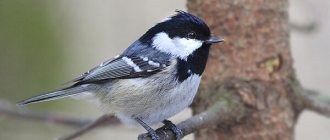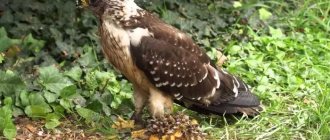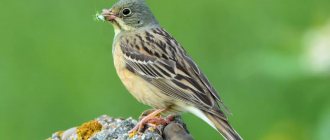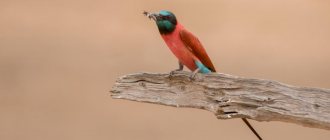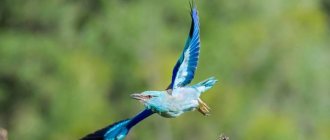Orioles are medium-sized birds that nest in trees. Males have bright plumage, females are duller.
Orioles live in forests all year round, and spend most of their time in the canopy of tall trees. The birds build a beautiful bowl-shaped nest of woven grasses, where the chicks are raised by both parents.
The oriole is a cute bird in appearance and its singing is melodious.
Description of the bird
Oriole bird photo and description
The oriole is a small bird with a bright color. The scientific name of the bird is Oriolus. The root of the word is similar to the Latin word aureolus, which means “golden.” Most likely, the bird acquired its name due to its colorful and rich coloration.
— Advertising —
The oriole is a songbird. Her voice resembles the sounds of a flute. The male’s singing is especially significant; it is with the help of his voice that he attracts the female. But sometimes the singing of an oriole is identical to the meowing of a cat. This timbre speaks of the danger that these birds portend.
According to the scientific classification, the oriole belongs to the class of birds, order - passeriformes, family - orioles.
The bird usually measures 24–25 cm in length. The wingspan reaches 45 cm. The body weight of the oriole rarely reaches 100 grams. Typically their weight ranges from 50 to 90 grams. According to the color, you can easily distinguish a male from a female.
The plumage of the male is bright gold and yellow. The wings are black, as is the tail. Females have a green-yellow base at the neck, and white underparts. The color of the female's wings is predominantly gray, less often green. The beak has a color variation: from pink to dark brown.
Lifespan.
The life expectancy of the small oriole bird is short. The maximum is fifteen years. Too many natural enemies:
- Birds of prey
: hawks, owls, crows, dwarf eagle, etc. - Small mammals:
martens, flying foxes, monkeys. - Reptiles:
snakes, large lizards.
In addition to predators, the oriole in the wild is threatened by competing birds; sparrows, cuckoos, bluethroats and magpies also instilled timidity and caution in the bird. Another enemy of the oriole is climate change, natural disasters, diseases and parasites. The anthropogenic factor also creates dangers for the oriole bird, however, in the Red Book this bird is listed as a species with minimal risk of extinction.
Photo of a yellow bird
What does it eat?
— Advertising —
Oriole sitting on a branch photo
Orioles are very peaceful and friendly birds. Among dozens of types of behavior, they are more likely to choose calm, phlegmatic observation rather than fuss.
In the list of orioles' favorite ingredients, insects and fruits come first. This is due to their habitat - orioles nest in trees. From this comes the ability to access insects such as mosquitoes, geese, butterflies, beetles, and some types of spiders. As for fruits, these birds feed on: pears, cherries, apricots, currants, and grapes.
Orioles give priority to feeding in the first half of the day. At all other times of the day, birds can only have a snack.
REPRODUCTION
A male oriole, arriving at the nesting site, announces himself with loud singing, reminiscent of the sound of a flute. The function of spring singing is to indicate the occupied territory. The male defends his possessions from competitors. Females arrive at nesting sites 2-3 days later than males. At this time, the birds split into pairs - old “marriage unions” are restored and new ones are formed. The pairs then look for places to build nests. Orioles build hammock nests at the ends of the upper branches of trees, with females doing most of the work. The base of the nest is woven in the fork of branches from bast and grass stems, after which it is held together with saliva. A hanging nest-basket or, as it is often called, a “hammock” is attached to the base. The tray is lined with grass, wool and feathers. The female lays 2-5 eggs. After 14-15 days, chicks hatch from the eggs. Parents tirelessly bring their babies food rich in protein, mainly insects.
Where does it live?
The oriole's distribution range covers the territories of Europe and Asia, Southwestern Siberia, and Northwestern Africa. Birds live in forests in trees, the locations of which are located near bodies of water. Orioles prefer sparse forests of birch or pine. But it is extremely difficult to see the oriole. The fact is that she likes to hide in the foliage, moreover, at a considerable height, at which it is impossible to see the oriole.
Migratory or wintering
Oriole bird sitting on a branch
Oriole is a migratory bird. In August she flies to Tropical Africa. It is interesting that the oriole, in comparison with others, arrives much later - in mid-May, when it is already quite warm outside.
The oriole never winters in Europe. This is due to the upcoming difficulty in finding food, as well as the inability to perceive the low air temperatures common in Europe.
Features of the oriole's migratory behavior
Spends the winter in northern and southern Africa. The oriole migrates mainly at night, although during the spring migration it also flies during the day. Orioles feed on fruit in Mediterranean regions before they reach their wintering grounds.
Oriole lives in:
- deciduous forests;
- groves;
- parks with tall trees;
- large gardens.
The bird visits orchards in search of food and is considered a pest in Mediterranean regions.
The oriole chooses oaks, poplars and ash to build nests. It prefers forests below 600 m above sea level, although it is found above 1800 m in Morocco and 2000 m in Russia.
During their migration to the South, birds settle among dry bushes in savannas, oases and on separately growing fig trees.
Kinds
In nature, there are more than 24 species of orioles, which differ from each other both significantly and imperceptibly. We will describe several of the most common ones.
Common oriole
Photo of a common oriole sitting on a branch
The most common species is the common oriole. This bird lives in Europe, Western Siberia, and Asia. The plumage is bright, the dominant colors are yellow, black, green. Typically, the common oriole has black wings, a silver-white belly, and a black tail edge. The oriole's beak is often brown. The birds weigh 50-90 grams, body length 24-25 cm.
The common oriole is not critical when it comes to food. Its diet includes fruits and small animals. This bird is the most common, unlike its other species. It is easy to recognize due to its bright colors, while other species have a more subdued range of colors.
Among the common orioles, it is customary to distinguish two subspecies. One of them has no spot in the area behind the eye (oriolus Linnaeus), while the other has one (kundoo Sykes).
Green-headed oriole
Green-headed oriole on a branch photo
The bird inhabits the territory of Kenya and Tanzania. She is a tropical species of oriole. The green oriole has designated tropical and subtropical rain forests as its favorite habitat. As we already know, the oriole nests near bodies of water. This is due to the special love of these birds for swimming. The oriole is commonly called a clean bird, as it often dives into water to wash itself.
The green oriole has smaller parameters than the common one. Its body length is no more than 24 cm, and its weight is up to 65 grams. The dominant color is green and all its possible shades. Most often, the green or yellow color of the oriole is only a small skein on the body; usually it forms a line along the neck and a stripe on the abdomen. The legs are colored blue, and the beak is dark brown.
Striped oriole
Striped oriole sitting on a branch photo
This species is especially common in New Guinea and Australia. The striped oriole chooses eucalyptus forests for settlement. The coloring of these birds is less bright. Pastel colors predominate, muted green and gray dominate. Body length 26-28 cm. Weight 96 grams.
Chinese black-headed oriole
Chinese black-headed oriole sitting on a branch photo
Lives in Southeast Asia: China, Korea, Philippines, Java island. The Chinese black-headed oriole is predominantly brightly colored with particularly pronounced colors: yellow, green and white in females, and golden and black in males. These birds have a red beak. Dimensions: 23-26 cm, weight – 90 grams. Life expectancy is 15 years.
Chinese black-headed orioles are very uncommunicative; they prefer not to leave their hiding area.
Oriole nun
Photo of oriole nun
Distribution: Ethiopia, Eritrea. Habitat: tropical rainforests. Colors: yellow, black and green. The head of the oriole nun is always black, the beak is brown-red.
Masked oriole
A masked oriole sits on a tree photo
. It lives in Africa, the Sahara among tropical rainforests, in dense bushes and thickets. The plumage is bright, yellow and golden colors dominate. The beak is flesh-colored.
Great-billed Oriole
Photo of a large-billed oriole sitting on a branch.
This bird species is common in Africa, especially on the island of Sao Tome. This is easy to explain - this island is famous for its dense forests, which orioles adore so much. The birds got their name due to their wide beak. It is characteristic only of this species of orioles.
The large-billed oriole does not exceed 22 cm in body length and 50-55 grams in weight. In this species, sexual dimorphism is especially noticeable: males have a black head, females have a lighter, gray head. In addition, in females you can notice streaks along the body. Both sexes have a pale pink beak, sometimes dark burgundy, yellow undertail, and dark wings.
How do they reproduce?
Feeding oriole chicks by the male
Monogamous orioles breed once a year. Males usually arrive before females. While flirting, orioles sing beautifully, whistle and chirp. In the event of a quarrel between males, even fights can occur. Orioles very jealously guard their territory and the female.
The nest, which resembles a small hanging basket, is usually located high in the tree, closer to the edge of the crown. Their clutch most often consists of 3-5 eggs. The eggs are pink or cream colored and have some bright red speckles. The female incubates the eggs for about two weeks. Only sometimes can a male replace her at “post.” After birth, the chicks are fed by their parents for fifteen days.
Oriole eggs in a nest
Orioles carefully protect their offspring. They fearlessly fight birds that decide to eat chicks or eggs.
Female and male: main differences
Photo of a female and male oriole
Sexual dimorphism of the oriole lies in the variety of plumage. Most often, males have a golden hue and black wings with a tail. In the female, green and yellow are dominant - in the upper part of the body and a white belly. The wings are colored gray-green.
From this it emerges that sexual dimorphism in birds is strongly expressed.
The beak of both sexes is quite pronounced - it is long, the color is brown or dark pink. As for size, the male and female do not differ much in body weight and size. The only thing is the more noticeable elegance of the female, the elongation of the neck.
Sign language used by orioles to communicate with each other
During the breeding season, the male sings loudly at dawn and dusk over his territory. Defensive behavior is also accompanied by loud noises.
When threatening an opponent or enemies, the oriole turns its body from side to side and ruffles its neck feathers, singing a song, increasing the number of notes, speed and intensity of the melody.
When other birds fly into the nesting territory, birds of both sexes adopt aggressive postures, opening their wings, flaring their tails and extending their heads forward, and fly in front of the intruders. Birds also react with these poses to other manifestations of threats and accompany them with screams, flapping their wings and striking with their beaks.
Chases and physical contacts are sometimes, but rarely, accompanied by a collision in the air or a fall to the ground, with the bird's paws holding the opponent. These interactions sometimes result in injury or death to one of the orioles.
Keeping at home and breeding
Bird lovers often prefer these small colored birds. But if you decide to keep an oriole at home, then you need to familiarize yourself with a number of rules and restrictions.
Oriole feeding in a cage photo
Under no circumstances should you catch this bird and put it in a cage. Orioles are very freedom-loving birds. In captivity they will live no more than 3-5 days. It's another matter if you tame a small chick. But you should know that an oriole will never sing in a cage. If this freedom-loving bird resigns itself to captivity, then you still will not be able to hear its flute voice.
Orioles are cautious and timid. They prefer to please people away from them. Orioles are not domestic birds. Unfortunately, you won't be able to please the oriole. She prefers to eat found animals rather than purchased food. Due to eating disorders, many of these birds do not survive. This once again confirms that the oriole is destined for freedom. The human hand will only harm her.
From this it turns out that breeding an oriole at home is a very difficult task, sometimes impossible. Even the most avid bird lovers will have an oriole that will live no more than 3 years without offspring.
If you decide to get an oriole, then be sure to buy a large cage - the oriole loves to fight from corner to corner. Its feathers are soft, and if the cage is small, there is a risk that the bird will injure its feathers.
The oriole feels much better in its natural environment. The oriole is a monogamous bird - it chooses a mate for life. During the year, the female nurses 3-4 chicks. The incubation period for eggs lasts about 15 days. Basically, the female incubates; the male can only replace her for a few hours. The parents feed the little birds, first with bugs and then with berries. In general, orioles feed their chicks about 210 times a day - 10-15 times per hour. At the age of 15-17 days, the little oriole can already fly.
Nutrition
The diet of orioles is quite varied. They eat not only protein animal foods, but also lean plant foods. Taking into account the season and habitat, gourmets diversify the menu with ripe berries: cherries, currants, rowan, grapes, bird cherry, everything that is ripe and fragrant. They enjoy the juicy fruits of pears, figs and mangoes.
Despite such fruit and berry predilections, they cannot be called destroyers of gardens. Firstly, they are very shy and do not linger in busy places. And secondly, the basis of their table is made up of various insects - midges, mosquitoes, insects, caterpillars, dragonflies, worms, butterflies, boogers, bugs, spiders.
Baltimore oriole
Everything that jumps, crawls, runs and flies. And it is considered harmful to the garden. It turns out that they are nature's orderlies. Orioles are one of the brave birds that even eat furry poisonous caterpillars, after killing them with several blows against a tree.
Sometimes these birds even destroy the nests of other small birds - redstarts or flycatchers. They peck the eggs. In addition, near the water they can catch a snail or a small river mollusk. The oriole flies quickly, capable of reaching speeds of up to 45 km/h. But from the outside it seems that she is floating through the air, her movements are so smooth.
But often they also become the subject of hunting for other birds - hawk, kite, eagle and falcon. Birds are especially vulnerable during nesting. A married couple in love loses their vigilance and becomes easy prey for raiders. That is why they try to build nests in hard-to-reach places.
Interesting Facts
- Oriole has a charming voice. The sounds of singing resemble the sound of a flute and have a calming effect on a person.
- The oriole nests only near bodies of water. This bird likes to “take a bath” several times a day.
- It is difficult for humans to see the oriole because it lives high in the trees.
- The oriole's nest resembles a bag. It hangs from the branches.
- Oriole is a forest orderly. This bird eats forest pests - hairy caterpillars, which are poisonous and pose a danger to plants.
Natural enemies
Orioles are very vulnerable to large birds of prey. They are often attacked by falcons, eagles, hawks and kites, especially during the nesting season, when the birds are somewhat less vigilant. But thanks to the high location of the nests, they are protected from terrestrial predators.
Photo: tkani1.ru
Starling (50 photos): description of the bird, habitat and what it eats






